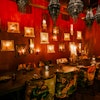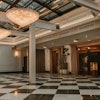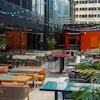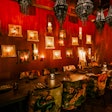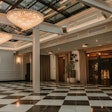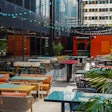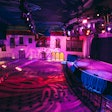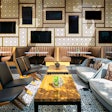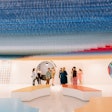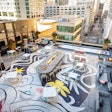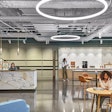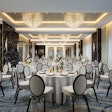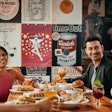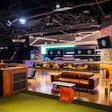On Tuesday night, the Art Institute of Chicago stayed open hours past its typical closing time for "A Royal Gala," which celebrated the opening of "Benin," a new exhibition of Nigerian court art. Produced by the museum's leadership advisory committee, with planning efforts spearheaded by the committee's associate director Erin Gilbert, the event featured cocktails, dancing, an on-stage presentation within the museum's auditorium, and—in a separate wing—a sponsor dinner (where tickets cost $1,000 a pop).
An hour before the bulk of the evening's 800 guests arrived, top ticket holders were privy to a curator-led tour of the exhibition. The ensuing sponsor dinner took place in one of the newly renovated galleries, where guests like Mayor Richard M. Daley, Reverend Jesse Jackson, and Nigerian dignitaries in town for the occasion sat at tables crowned with tall, palm leaf-adorned centerpieces.During the dinner, a cocktail reception for the rest of the crowd (who had paid $200 a head) took place on the other side of the museum, spanning three levels. In the first floor Stock Exchange Trading Room, guests ate red pepper hummus, grilled flank steak, and baked tilapia provided by the Art Institute's in-house catering firm, while a cover band played classics like "My Girl" in front of a small dance floor; buffets and bars also occupied the museum's lower-level Garden Restaurant and second-floor Millennium Park Room.
The "Benin" exhibition was open for viewing throughout the dinner and the concurrent cocktail reception, resulting in a gallery filled with a mix of attires: Women in evening gowns and men in tuxedos walked to the exhibition by way of the dinner, perusing the court art beside more casually attired guests who came over from the cocktail party on the other side of the museum. The exhibition was in the middle of the museum, which caused confusion for some guests as they watched people converging on the gallery from multiple directions. "I have to call my secretary to find out where I should be," said one tuxedoed guest, while scrolling through his BlackBerry.
To keep guests on the right track, museum staffers and guards stood at seemingly every checkpoint throughout the museum, guiding attendees to the sit-down dinner, buffet dinner, or exhibition. The crowd ultimately converged for a presentation within the museum's Rubloff Auditorium, where a troupe of dancers and drummers escorted Nigerian princess Theresa Erediauwa to her front-row seat. After the presentation, which involved a Nigerian blessing ceremony and remarks from the museum's curator of African Art, guests ended the evening with a dessert buffet housed in the same rooms as the dinner reception.
An hour before the bulk of the evening's 800 guests arrived, top ticket holders were privy to a curator-led tour of the exhibition. The ensuing sponsor dinner took place in one of the newly renovated galleries, where guests like Mayor Richard M. Daley, Reverend Jesse Jackson, and Nigerian dignitaries in town for the occasion sat at tables crowned with tall, palm leaf-adorned centerpieces.During the dinner, a cocktail reception for the rest of the crowd (who had paid $200 a head) took place on the other side of the museum, spanning three levels. In the first floor Stock Exchange Trading Room, guests ate red pepper hummus, grilled flank steak, and baked tilapia provided by the Art Institute's in-house catering firm, while a cover band played classics like "My Girl" in front of a small dance floor; buffets and bars also occupied the museum's lower-level Garden Restaurant and second-floor Millennium Park Room.
The "Benin" exhibition was open for viewing throughout the dinner and the concurrent cocktail reception, resulting in a gallery filled with a mix of attires: Women in evening gowns and men in tuxedos walked to the exhibition by way of the dinner, perusing the court art beside more casually attired guests who came over from the cocktail party on the other side of the museum. The exhibition was in the middle of the museum, which caused confusion for some guests as they watched people converging on the gallery from multiple directions. "I have to call my secretary to find out where I should be," said one tuxedoed guest, while scrolling through his BlackBerry.
To keep guests on the right track, museum staffers and guards stood at seemingly every checkpoint throughout the museum, guiding attendees to the sit-down dinner, buffet dinner, or exhibition. The crowd ultimately converged for a presentation within the museum's Rubloff Auditorium, where a troupe of dancers and drummers escorted Nigerian princess Theresa Erediauwa to her front-row seat. After the presentation, which involved a Nigerian blessing ceremony and remarks from the museum's curator of African Art, guests ended the evening with a dessert buffet housed in the same rooms as the dinner reception.
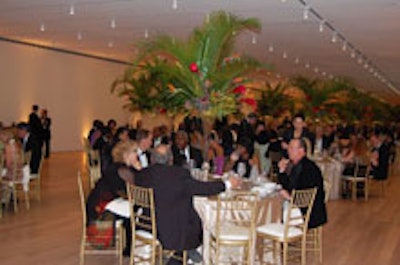
The V.I.P. dinner reception at the Art Institute's Royal Gala
Photo: BizBash
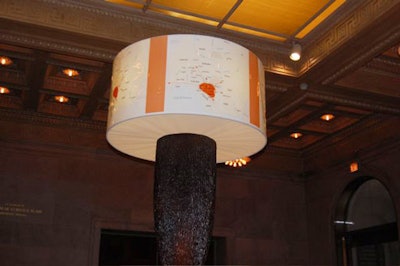
At the museum's Michigan Avenue entrance, a lamp crowned with a map of Africa stood above the main desk, in a spot where floral arrangements are typically housed.
Photo: BizBash
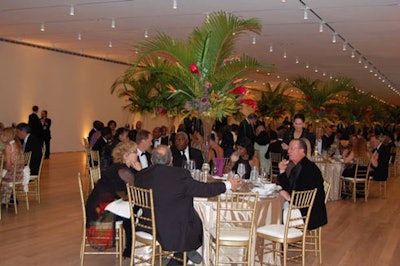
Heffernan Morgan provided palm leaf-studded floral arrangements for the tables at the sponsor dinner.
Photo: BizBash
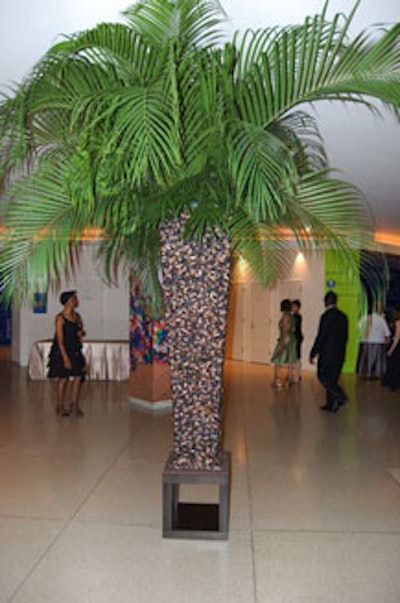
To enhance the evening's Nigerian theme, Heffernan Morgan created faux palm trees, which stood throughout the museum and framed the entrance to the sponsor dinner.
Photo: BizBash
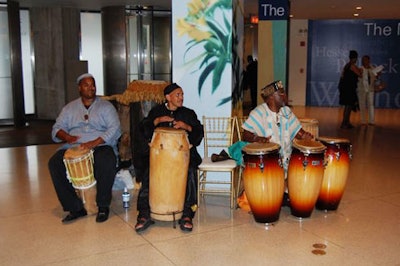
Inside the museum's Columbus Street entrance, drummers provided a welcome concert.
Photo: BizBash

